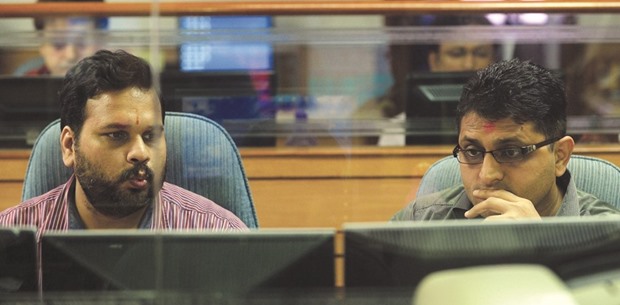Indian equities are expensive even after the worst start to the year since 2011 for the most accurate forecaster for the nation’s benchmark stock index. The reason: earnings.
Company earnings will grow 12% in 2016, slower than the “very optimistic” 18.5% forecast by analysts, Devendra Joshi, Asia equity strategist at HSBC Holdings, said in a phone interview from Hong Kong. The S&P BSE Sensex ended 2015 within 1% of his year-end target of 25,800, the closest call among the gauge’s forecasters.
The Sensex, which tumbled into a bear market last month, is still valued at a 47% premium over a gauge of emerging markets.
The valuation may not sustain as a recovery in corporate profitability is taking longer than expected, Joshi said. Net incomes at the 30 index members have declined in four of the last five quarters, according data compiled by Bloomberg. The declining streak is the worst since 2008 when profits fell for six straight quarters amid the global financial crisis, the data show.
“Earnings expectations still need to come down and, as such, valuations are still high on a relative basis versus the rest of the region,” Joshi said, while maintaining his year-end Sensex target at 27,000. “Economic growth has been high last year but we have not seen it trickling through to earnings.”
While India is forecast to overtake a slowing China as the world’s fastest-growing big economy, back-to-back years of poor rainfall have eroded incomes of the bulk of the nation’s population even as rising bad loans at lenders have weighed on their profits.
Credit Suisse on Tuesday turned “bearish” on India, citing “unjustifiable premiums,” while Goldman Sachs Group on March 2 cut its 2016 earnings growth forecast for the NSE Nifty 50 Index by 2 percentage points to 10%.
Indian stocks, the rupee and bonds saw their worst January and February since 2011, as global funds pulled a combined $2.9bn from local shares amid anxiety about global growth. The Sensex trades at 17.7 times one-year forward earnings, versus a multiple of 12 for the MSCI Emerging Markets Index. The premium reached 63% in January, data compiled by Bloomberg show.
Last week’s 6.4% jump in the Sensex, the best performance since December 2011, hasn’t prompted Joshi to review his underweight recommendation on Indian stocks.
He’s bearish on industrials, raw-material producers and telecom companies. Consumer staples, drugmakers and utilities are on his buy list.
The gauge climbed for seven out of eight days after Finance Minister Arun Jaitley in his February 29 budget pledged to further shrink the fiscal gap, stoking speculation of an interest-rate cut by the central bank.
The budget, which aims to boost spending on rural projects, has coincided with a rebound in global commodities that has spurred capital inflows into the riskier emerging markets. Foreigners have bought $1.2bn of Indian shares so far this month, paring this year’s outflows to $1.6bn.
“The budget has been positive for sentiments, which we’ve seen in market movements, but we need to see how it is followed through,” Joshi said.

Indian stock brokers watch share prices on their trading screens at a brokerage house in Mumbai (file). The Sensex, which tumbled into a bear market last month, is still valued at a 47% premium over a gauge of emerging markets.


